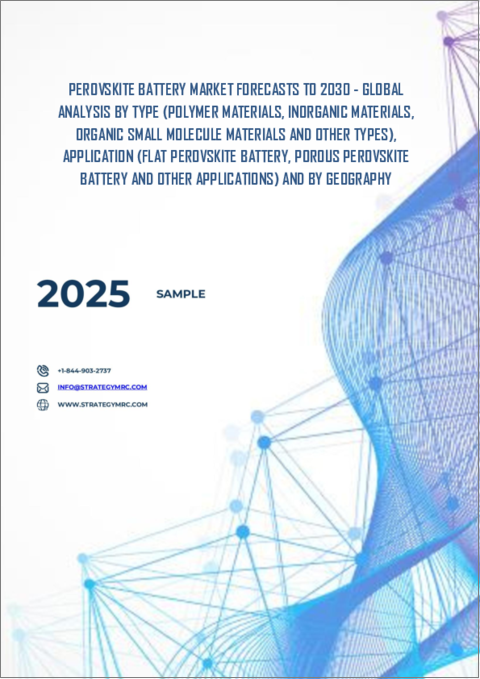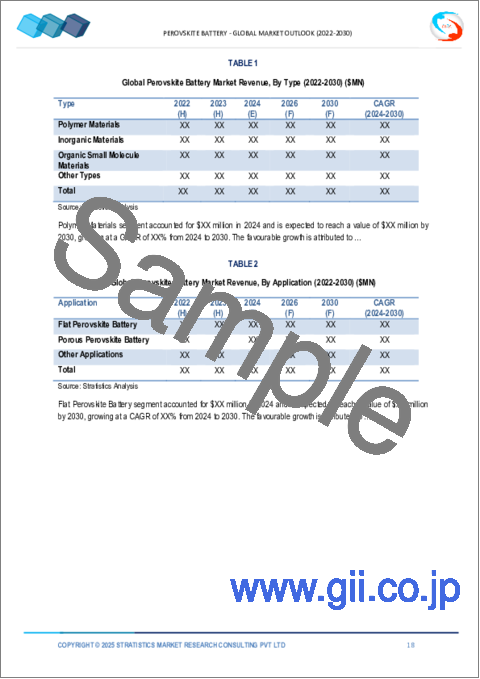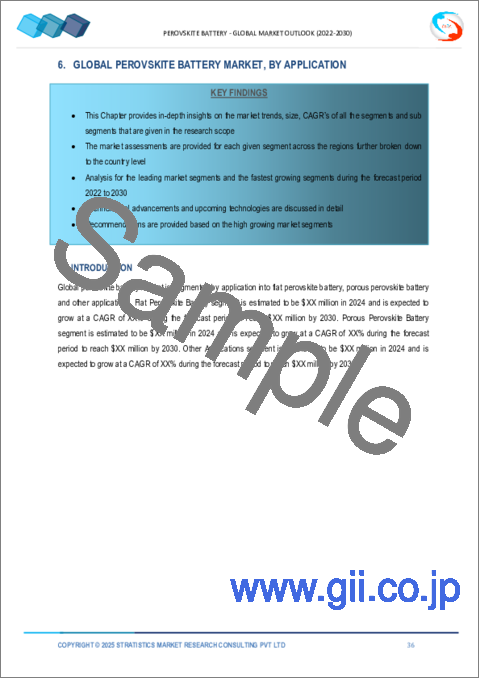|
|
市場調査レポート
商品コード
1569804
ペロブスカイト電池市場の2030年までの予測: タイプ別、用途別、地域別の世界分析Perovskite Battery Market Forecasts to 2030 - Global Analysis By Type, Application and By Geography |
||||||
カスタマイズ可能
|
|||||||
| ペロブスカイト電池市場の2030年までの予測: タイプ別、用途別、地域別の世界分析 |
|
出版日: 2024年10月10日
発行: Stratistics Market Research Consulting
ページ情報: 英文 200+ Pages
納期: 2~3営業日
|
全表示
- 概要
- 図表
- 目次
Stratistics MRCによると、ペロブスカイト電池の世界市場は予測期間中にCAGR 25.5%で成長しています。
ペロブスカイト電池は、鉱物ペロブスカイトに似た特定の結晶構造を持つ化合物であるペロブスカイト材料を利用したエネルギー貯蔵デバイスの一種です。ペロブスカイト電池は、従来のリチウムイオン電池に比べ、高効率、安定性、柔軟性に優れています。太陽電池によく使われるペロブスカイトは、低コスト生産、高い電気伝導性、新しい化学反応の可能性などの利点を備えています。ペロブスカイト電池では、これらの材料は電極または電解質として機能し、高容量や高速充放電速度といった性能指標の向上を可能にします。
再生可能エネルギー貯蔵への需要の高まり
多彩な結晶構造で知られるペロブスカイト材料は、高エネルギー密度、低コスト、製造の容易さなど、従来の電池技術にはないいくつかの利点を提供します。太陽光や風力などの再生可能エネルギーが普及するにつれ、効率的でスケーラブルなストレージ・ソリューションは、需要と供給のバランスを取る上で極めて重要になっています。ペロブスカイト電池は、高性能と適応性が期待され、実行可能な選択肢として浮上しています。研究者たちは、増大するエネルギー貯蔵のニーズに応えるため、その安定性、寿命、効率の向上に注力しています。
知的財産の問題
知的財産権(IP)の問題は、次世代エネルギー貯蔵に有望なペロブスカイト電池の開発と商業化を大きく妨げています。ペロブスカイト技術の複雑さには、多数の独自プロセス、材料、設計が含まれ、特許や知的財産権の主張が錯綜しています。企業や研究機関はしばしば、特許権、ライセンス契約、企業秘密をめぐる紛争に巻き込まれます。このような分断は、コストの増大、開発の遅延、企業間の協力関係の制限につながる可能性があります。
インフラ整備
インフラの強化は、精密な材料合成・加工のための高度なツールを備えた専門製造施設の設立を促進します。サプライチェーンが改善されれば、ペロブスカイト電池の生産に必要な高品質の原材料が安定して入手できるようになります。さらに、研究開発インフラへの投資は、新しいペロブスカイト材料と電池設計の革新をサポートし、性能と寿命を最適化します。効率的な試験・品質管理ラボにより、電池の効率と安全性を厳密に評価することができます。
安定性の問題
ペロブスカイト電池は、その高効率と低製造コストから有望視されているもの、実用化の妨げとなる重大な安定性の問題に直面しています。主な課題は、ペロブスカイト材料の化学的・構造的不安定性にあり、湿気、熱、紫外線などの環境条件下で急速に劣化する可能性があります。この劣化は電池の性能と寿命に影響し、従来の電池技術に比べて信頼性が低くなります。ペロブスカイト材料はイオンマイグレーションや相分離を起こしやすく、安定性をさらに損なう。
COVID-19の影響:
COVID-19の大流行は、再生可能エネルギー貯蔵のための有望な技術であるペロブスカイト電池の開発と研究に大きな影響を与えました。この危機は世界のサプライチェーンを混乱させ、ペロブスカイト電池の生産に必要不可欠な材料や部品の不足を引き起こしました。ロックダウンや社会的距離を置く措置は、研究所の研究を遅らせ、実験セットアップの進展を止めました。多くの研究機関や企業は予算の制約に直面し、資金を当面のパンデミック関連の課題に対処するために振り向け、進行中のプロジェクトを遅らせたり、中止したりもしました。海外への渡航が制限され、共同研究の機会も限られていたため、研究者間の知識やアイデアの交換が妨げられました。
予測期間中、無機材料分野が最大となる見込み
予測期間中、無機材料分野が最大となる見込み。多彩な構造特性で知られるペロブスカイト材料は、こうした電池の効率と寿命を向上させるために最適化が進められています。研究者は、ペロブスカイト層の組成と安定性を改良して性能を高めることに注力しており、より高いエネルギー密度とより速い充放電サイクルの達成を目指しています。劣化を最小限に抑え、全体的な耐久性を向上させるために、化学組成を調整し、高度な電解質を統合するなどの革新が行われています。
予測期間中、多孔質ペロブスカイト電池分野のCAGRが最も高くなると予想されます。
多孔質ペロブスカイト電池分野は、従来のペロブスカイト電池を多孔質構造で強化することで、予測期間中のCAGRが最も高くなると予想されます。この技術革新は、高い効率と安定性で知られるペロブスカイト材料のユニークな特性を活用して、優れた性能を持つ電池を作り出すものです。多孔質設計を取り入れることで、電池はイオン移動度と表面積を向上させ、より速い充放電速度を実現します。この構造により、電気活性物質の高密度化が可能になり、電池のエネルギー貯蔵容量と全体的な寿命が向上します。
最大のシェアを占める地域
アジア太平洋地域が、予測期間中、市場で最大のシェアを占めています。中国、日本、韓国などの国々は、専門知識、資源、投資を結集して、この有望な分野における技術革新と商業化を推進しています。学術機関、研究センター、業界のリーダーたちは、技術的課題を克服し、生産規模を拡大し、ペロブスカイト電池の効率と安定性を高めるために協力しています。このようなパートナーシップは、ダイナミックな知識の交換を促進し、最先端の研究と実用的な応用を統合することで進歩を加速させる。また、政府機関と非公開会社の共同事業も、重要な資金と支援を提供し、大規模なパイロット・プロジェクトと市場参入を促進しています。こうした要素が地域の成長を後押ししています。
CAGRが最も高い地域:
欧州地域は、野心的な持続可能性とイノベーションの目標を設定することにより、予測期間中に有益な成長を示すと推定されます。欧州連合(EU)の厳しい環境政策と資金援助イニシアティブは、従来の電池技術に比べて高効率で製造コストが低い可能性があるため、ペロブスカイト材料の研究を促進しています。欧州グリーン・ディールやホライゾン・欧州などの規制は、研究と商業化のための助成金、補助金、税制優遇措置を提供することで、ペロブスカイト電池を含むクリーンエネルギー・ソリューションへの投資を促進しています。このような政策により、技術的進歩が加速されるだけでなく、新しいバッテリーソリューションが地域全体で環境への影響と性能に関する高い基準を満たすことが保証されます。
無料のカスタマイズサービス:
本レポートをご購読のお客様には、以下の無料カスタマイズオプションのいずれかをご利用いただけます:
- 企業プロファイル
- 追加市場プレーヤーの包括的プロファイリング(3社まで)
- 主要企業のSWOT分析(3社まで)
- 地域セグメンテーション
- 顧客の関心に応じた主要国の市場推計・予測・CAGR(注:フィージビリティチェックによる)
- 競合ベンチマーキング
- 製品ポートフォリオ、地理的プレゼンス、戦略的提携に基づく主要企業のベンチマーキング
目次
第1章 エグゼクティブサマリー
第2章 序文
- 概要
- ステークホルダー
- 調査範囲
- 調査手法
- データマイニング
- データ分析
- データ検証
- 調査アプローチ
- 調査情報源
- 1次調査情報源
- 2次調査情報源
- 前提条件
第3章 市場動向分析
- 促進要因
- 抑制要因
- 機会
- 脅威
- 用途分析
- 新興市場
- COVID-19の影響
第4章 ポーターのファイブフォース分析
- 供給企業の交渉力
- 買い手の交渉力
- 代替品の脅威
- 新規参入業者の脅威
- 競争企業間の敵対関係
第5章 世界のペロブスカイト電池市場:タイプ別
- ポリマー材料
- 無機材料
- 有機小分子材料
- その他のタイプ
第6章 世界のペロブスカイト電池市場:用途別
- フラットペロブスカイト電池
- 多孔質ペロブスカイト電池
- その他の用途
第7章 世界のペロブスカイト電池市場:地域別
- 北米
- 米国
- カナダ
- メキシコ
- 欧州
- ドイツ
- 英国
- イタリア
- フランス
- スペイン
- その他欧州
- アジア太平洋
- 日本
- 中国
- インド
- オーストラリア
- ニュージーランド
- 韓国
- その他アジア太平洋地域
- 南米
- アルゼンチン
- ブラジル
- チリ
- その他南米
- 中東・アフリカ
- サウジアラビア
- アラブ首長国連邦
- カタール
- 南アフリカ
- その他中東とアフリカ
第8章 主な発展
- 契約、パートナーシップ、コラボレーション、合弁事業
- 買収と合併
- 新製品発売
- 事業拡大
- その他の主要戦略
第9章 企業プロファイリング
- DuPont
- Eos Energy Enterprises
- Hodogaya Chemical
- Kyocera Corporation
- Panasonic Corporation
- Samsung SDI
- Saule Technologies
- Sharp Corporation
- SunPower Corporation
List of Tables
- Table 1 Global Perovskite Battery Market Outlook, By Region (2022-2030) ($MN)
- Table 2 Global Perovskite Battery Market Outlook, By Type (2022-2030) ($MN)
- Table 3 Global Perovskite Battery Market Outlook, By Polymer Materials (2022-2030) ($MN)
- Table 4 Global Perovskite Battery Market Outlook, By Inorganic Materials (2022-2030) ($MN)
- Table 5 Global Perovskite Battery Market Outlook, By Organic Small Molecule Materials (2022-2030) ($MN)
- Table 6 Global Perovskite Battery Market Outlook, By Other Types (2022-2030) ($MN)
- Table 7 Global Perovskite Battery Market Outlook, By Application (2022-2030) ($MN)
- Table 8 Global Perovskite Battery Market Outlook, By Flat Perovskite Battery (2022-2030) ($MN)
- Table 9 Global Perovskite Battery Market Outlook, By Porous Perovskite Battery (2022-2030) ($MN)
- Table 10 Global Perovskite Battery Market Outlook, By Other Applications (2022-2030) ($MN)
- Table 11 North America Perovskite Battery Market Outlook, By Country (2022-2030) ($MN)
- Table 12 North America Perovskite Battery Market Outlook, By Type (2022-2030) ($MN)
- Table 13 North America Perovskite Battery Market Outlook, By Polymer Materials (2022-2030) ($MN)
- Table 14 North America Perovskite Battery Market Outlook, By Inorganic Materials (2022-2030) ($MN)
- Table 15 North America Perovskite Battery Market Outlook, By Organic Small Molecule Materials (2022-2030) ($MN)
- Table 16 North America Perovskite Battery Market Outlook, By Other Types (2022-2030) ($MN)
- Table 17 North America Perovskite Battery Market Outlook, By Application (2022-2030) ($MN)
- Table 18 North America Perovskite Battery Market Outlook, By Flat Perovskite Battery (2022-2030) ($MN)
- Table 19 North America Perovskite Battery Market Outlook, By Porous Perovskite Battery (2022-2030) ($MN)
- Table 20 North America Perovskite Battery Market Outlook, By Other Applications (2022-2030) ($MN)
- Table 21 Europe Perovskite Battery Market Outlook, By Country (2022-2030) ($MN)
- Table 22 Europe Perovskite Battery Market Outlook, By Type (2022-2030) ($MN)
- Table 23 Europe Perovskite Battery Market Outlook, By Polymer Materials (2022-2030) ($MN)
- Table 24 Europe Perovskite Battery Market Outlook, By Inorganic Materials (2022-2030) ($MN)
- Table 25 Europe Perovskite Battery Market Outlook, By Organic Small Molecule Materials (2022-2030) ($MN)
- Table 26 Europe Perovskite Battery Market Outlook, By Other Types (2022-2030) ($MN)
- Table 27 Europe Perovskite Battery Market Outlook, By Application (2022-2030) ($MN)
- Table 28 Europe Perovskite Battery Market Outlook, By Flat Perovskite Battery (2022-2030) ($MN)
- Table 29 Europe Perovskite Battery Market Outlook, By Porous Perovskite Battery (2022-2030) ($MN)
- Table 30 Europe Perovskite Battery Market Outlook, By Other Applications (2022-2030) ($MN)
- Table 31 Asia Pacific Perovskite Battery Market Outlook, By Country (2022-2030) ($MN)
- Table 32 Asia Pacific Perovskite Battery Market Outlook, By Type (2022-2030) ($MN)
- Table 33 Asia Pacific Perovskite Battery Market Outlook, By Polymer Materials (2022-2030) ($MN)
- Table 34 Asia Pacific Perovskite Battery Market Outlook, By Inorganic Materials (2022-2030) ($MN)
- Table 35 Asia Pacific Perovskite Battery Market Outlook, By Organic Small Molecule Materials (2022-2030) ($MN)
- Table 36 Asia Pacific Perovskite Battery Market Outlook, By Other Types (2022-2030) ($MN)
- Table 37 Asia Pacific Perovskite Battery Market Outlook, By Application (2022-2030) ($MN)
- Table 38 Asia Pacific Perovskite Battery Market Outlook, By Flat Perovskite Battery (2022-2030) ($MN)
- Table 39 Asia Pacific Perovskite Battery Market Outlook, By Porous Perovskite Battery (2022-2030) ($MN)
- Table 40 Asia Pacific Perovskite Battery Market Outlook, By Other Applications (2022-2030) ($MN)
- Table 41 South America Perovskite Battery Market Outlook, By Country (2022-2030) ($MN)
- Table 42 South America Perovskite Battery Market Outlook, By Type (2022-2030) ($MN)
- Table 43 South America Perovskite Battery Market Outlook, By Polymer Materials (2022-2030) ($MN)
- Table 44 South America Perovskite Battery Market Outlook, By Inorganic Materials (2022-2030) ($MN)
- Table 45 South America Perovskite Battery Market Outlook, By Organic Small Molecule Materials (2022-2030) ($MN)
- Table 46 South America Perovskite Battery Market Outlook, By Other Types (2022-2030) ($MN)
- Table 47 South America Perovskite Battery Market Outlook, By Application (2022-2030) ($MN)
- Table 48 South America Perovskite Battery Market Outlook, By Flat Perovskite Battery (2022-2030) ($MN)
- Table 49 South America Perovskite Battery Market Outlook, By Porous Perovskite Battery (2022-2030) ($MN)
- Table 50 South America Perovskite Battery Market Outlook, By Other Applications (2022-2030) ($MN)
- Table 51 Middle East & Africa Perovskite Battery Market Outlook, By Country (2022-2030) ($MN)
- Table 52 Middle East & Africa Perovskite Battery Market Outlook, By Type (2022-2030) ($MN)
- Table 53 Middle East & Africa Perovskite Battery Market Outlook, By Polymer Materials (2022-2030) ($MN)
- Table 54 Middle East & Africa Perovskite Battery Market Outlook, By Inorganic Materials (2022-2030) ($MN)
- Table 55 Middle East & Africa Perovskite Battery Market Outlook, By Organic Small Molecule Materials (2022-2030) ($MN)
- Table 56 Middle East & Africa Perovskite Battery Market Outlook, By Other Types (2022-2030) ($MN)
- Table 57 Middle East & Africa Perovskite Battery Market Outlook, By Application (2022-2030) ($MN)
- Table 58 Middle East & Africa Perovskite Battery Market Outlook, By Flat Perovskite Battery (2022-2030) ($MN)
- Table 59 Middle East & Africa Perovskite Battery Market Outlook, By Porous Perovskite Battery (2022-2030) ($MN)
- Table 60 Middle East & Africa Perovskite Battery Market Outlook, By Other Applications (2022-2030) ($MN)
According to Stratistics MRC, the Global Perovskite Battery Market is growing at a CAGR of 25.5% during the forecast period. A perovskite battery is a type of energy storage device that utilizes perovskite materials, which are compounds with a specific crystal structure similar to the mineral perovskite. These batteries are notable for their high efficiency, stability, and flexibility compared to traditional lithium-ion batteries. Perovskites, often used in solar cells, offer advantages such as low-cost production, high electrical conductivity, and the potential for novel chemistries. In perovskite batteries, these materials serve as either electrodes or electrolytes, enabling enhanced performance metrics like higher capacity and faster charge/discharge rates.
Market Dynamics:
Driver:
Growing demand for renewable energy storage
Perovskite materials, known for their versatile crystal structures, offer several advantages over traditional battery technologies, including high energy density, low cost, and ease of fabrication. As renewable energy sources like solar and wind become more prevalent, efficient and scalable storage solutions are crucial for balancing supply and demand. Perovskite batteries, with their potential for high performance and adaptability, are emerging as a viable option. Researchers are focusing on enhancing their stability, longevity, and efficiency to meet the growing energy storage needs.
Restraint:
Intellectual property issues
Intellectual property (IP) issues are significantly impeding the development and commercialization of Perovskite batteries, which hold promise for next-generation energy storage. The complexity of Perovskite technology involves numerous proprietary processes, materials, and designs, creating a tangled web of patents and IP claims. Companies and research institutions often find themselves entangled in disputes over patent rights, licensing agreements, and trade secrets. This fragmentation can lead to increased costs, delayed development, and limited collaboration between entities.
Opportunity:
Infrastructure development
Enhanced infrastructure facilitates the establishment of specialized manufacturing facilities equipped with advanced tools for precise material synthesis and processing. Improved supply chains ensure the consistent availability of high-quality raw materials needed for Perovskite battery production. Additionally, investments in research and development infrastructure support the innovation of new Perovskite materials and battery designs, optimizing performance and longevity. Efficient testing and quality control labs enable rigorous evaluation of battery efficiency and safety.
Threat:
Stability issues
Perovskite batteries, while promising due to their high efficiency and low production costs, face significant stability issues that hinder their practical application. The primary challenge lies in the chemical and structural instability of perovskite materials, which can degrade rapidly under environmental conditions such as moisture, heat, and UV light. This degradation affects the battery's performance and lifespan, making them less reliable compared to traditional battery technologies. The perovskite materials are prone to ion migration and phase segregation, which further compromises their stability.
Covid-19 Impact:
The COVID-19 pandemic significantly impacted the development and research of perovskite batteries, a promising technology for renewable energy storage. The crisis disrupted global supply chains, causing shortages of essential materials and components necessary for perovskite battery production. Lockdowns and social distancing measures slowed down laboratory research and halted progress on experimental setups. Many research institutions and companies faced budget constraints and redirected funds to address immediate pandemic-related challenges, delaying or even canceling ongoing projects. International travel restrictions and limited collaborative opportunities impeded the exchange of knowledge and ideas between researchers.
The Inorganic Materials segment is expected to be the largest during the forecast period
Inorganic Materials segment is expected to be the largest during the forecast period. Perovskite materials, known for their versatile structural properties, are being optimized to improve the efficiency and longevity of these batteries. Researchers are focusing on refining the composition and stability of the perovskite layers to boost performance, aiming to achieve higher energy densities and faster charge-discharge cycles. Innovations include tailoring the chemical composition and integrating advanced electrolytes to minimize degradation and enhance overall durability.
The Porous Perovskite Battery segment is expected to have the highest CAGR during the forecast period
Porous Perovskite Battery segment is expected to have the highest CAGR during the forecast period by enhancing the traditional perovskite battery with a porous structure. This innovation leverages the unique properties of perovskite materials-known for their high efficiency and stability-to create a battery with superior performance. By incorporating a porous design, the battery improves ion mobility and surface area, facilitating faster charge and discharge rates. This structure allows for a higher density of electroactive materials, which boosts the battery's energy storage capacity and overall lifespan.
Region with largest share:
Asia Pacific region commanded the largest share of the market over the extrapolated period. Countries such as China, Japan, and South Korea are pooling their expertise, resources, and investments to drive innovation and commercialization in this promising field. Academic institutions, research centers, and industry leaders are working together to overcome technical challenges, scale up production, and enhance the efficiency and stability of perovskite batteries. These partnerships foster a dynamic exchange of knowledge and accelerate progress by integrating cutting-edge research with practical applications. Joint ventures between government bodies and private companies also provide crucial funding and support, facilitating large-scale pilot projects and market entry. These elements are boosting the regional growth.
Region with highest CAGR:
Europe region is estimated to witness profitable growth during the projected period by setting ambitious sustainability and innovation targets. The European Union's stringent environmental policies and funding initiatives promote research into perovskite materials due to their potential for high efficiency and lower production costs compared to traditional battery technologies. Regulations such as the European Green Deal and Horizon Europe are driving investment in clean energy solutions, including perovskite batteries, by offering grants, subsidies, and tax incentives for research and commercialization. These policies not only accelerate technological advancements but also ensure that new battery solutions meet high standards for environmental impact and performance across the region.
Key players in the market
Some of the key players in Perovskite Battery market include DuPont, Eos Energy Enterprises, Hodogaya Chemical, Kyocera Corporation, Panasonic Corporation, Samsung SDI, Saule Technologies, Sharp Corporation and SunPower Corporation.
Key Developments:
In July 2024, Eos Energy Enterprises, a leading provider of safe, scalable, efficient, and sustainable zinc-based long duration energy storage systems, announced it has successfully launched commercial production on its first state-of-the-art (SotA) manufacturing line after being installed and commissioned in Turtle Creek, Pennsylvania, propelling the Company's ability to produce Eos Z3TM batteries at scale.
In March 2024, Kyocera Corporation released its new 5814 Series, a 0.3mm pitch Board-to-Board connector contributing to the miniaturization and expanding functionality of devices with its compact size. This connector achieves industry-leading narrow pitch and compact dimensions, with a stacking height of 0.6mm and width of 1.5mm, and is designed to prevent damage during connector mating operations through its unique metal fitting structure.
Types Covered:
- Polymer Materials
- Inorganic Materials
- Organic Small Molecule Materials
- Other Types
Applications Covered:
- Flat Perovskite Battery
- Porous Perovskite Battery
- Other Applications
Regions Covered:
- North America
- US
- Canada
- Mexico
- Europe
- Germany
- UK
- Italy
- France
- Spain
- Rest of Europe
- Asia Pacific
- Japan
- China
- India
- Australia
- New Zealand
- South Korea
- Rest of Asia Pacific
- South America
- Argentina
- Brazil
- Chile
- Rest of South America
- Middle East & Africa
- Saudi Arabia
- UAE
- Qatar
- South Africa
- Rest of Middle East & Africa
What our report offers:
- Market share assessments for the regional and country-level segments
- Strategic recommendations for the new entrants
- Covers Market data for the years 2022, 2023, 2024, 2026, and 2030
- Market Trends (Drivers, Constraints, Opportunities, Threats, Challenges, Investment Opportunities, and recommendations)
- Strategic recommendations in key business segments based on the market estimations
- Competitive landscaping mapping the key common trends
- Company profiling with detailed strategies, financials, and recent developments
- Supply chain trends mapping the latest technological advancements
Free Customization Offerings:
All the customers of this report will be entitled to receive one of the following free customization options:
- Company Profiling
- Comprehensive profiling of additional market players (up to 3)
- SWOT Analysis of key players (up to 3)
- Regional Segmentation
- Market estimations, Forecasts and CAGR of any prominent country as per the client's interest (Note: Depends on feasibility check)
- Competitive Benchmarking
- Benchmarking of key players based on product portfolio, geographical presence, and strategic alliances
Table of Contents
1 Executive Summary
2 Preface
- 2.1 Abstract
- 2.2 Stake Holders
- 2.3 Research Scope
- 2.4 Research Methodology
- 2.4.1 Data Mining
- 2.4.2 Data Analysis
- 2.4.3 Data Validation
- 2.4.4 Research Approach
- 2.5 Research Sources
- 2.5.1 Primary Research Sources
- 2.5.2 Secondary Research Sources
- 2.5.3 Assumptions
3 Market Trend Analysis
- 3.1 Introduction
- 3.2 Drivers
- 3.3 Restraints
- 3.4 Opportunities
- 3.5 Threats
- 3.6 Application Analysis
- 3.7 Emerging Markets
- 3.8 Impact of Covid-19
4 Porters Five Force Analysis
- 4.1 Bargaining power of suppliers
- 4.2 Bargaining power of buyers
- 4.3 Threat of substitutes
- 4.4 Threat of new entrants
- 4.5 Competitive rivalry
5 Global Perovskite Battery Market, By Type
- 5.1 Introduction
- 5.2 Polymer Materials
- 5.3 Inorganic Materials
- 5.4 Organic Small Molecule Materials
- 5.5 Other Types
6 Global Perovskite Battery Market, By Application
- 6.1 Introduction
- 6.2 Flat Perovskite Battery
- 6.3 Porous Perovskite Battery
- 6.4 Other Applications
7 Global Perovskite Battery Market, By Geography
- 7.1 Introduction
- 7.2 North America
- 7.2.1 US
- 7.2.2 Canada
- 7.2.3 Mexico
- 7.3 Europe
- 7.3.1 Germany
- 7.3.2 UK
- 7.3.3 Italy
- 7.3.4 France
- 7.3.5 Spain
- 7.3.6 Rest of Europe
- 7.4 Asia Pacific
- 7.4.1 Japan
- 7.4.2 China
- 7.4.3 India
- 7.4.4 Australia
- 7.4.5 New Zealand
- 7.4.6 South Korea
- 7.4.7 Rest of Asia Pacific
- 7.5 South America
- 7.5.1 Argentina
- 7.5.2 Brazil
- 7.5.3 Chile
- 7.5.4 Rest of South America
- 7.6 Middle East & Africa
- 7.6.1 Saudi Arabia
- 7.6.2 UAE
- 7.6.3 Qatar
- 7.6.4 South Africa
- 7.6.5 Rest of Middle East & Africa
8 Key Developments
- 8.1 Agreements, Partnerships, Collaborations and Joint Ventures
- 8.2 Acquisitions & Mergers
- 8.3 New Product Launch
- 8.4 Expansions
- 8.5 Other Key Strategies
9 Company Profiling
- 9.1 DuPont
- 9.2 Eos Energy Enterprises
- 9.3 Hodogaya Chemical
- 9.4 Kyocera Corporation
- 9.5 Panasonic Corporation
- 9.6 Samsung SDI
- 9.7 Saule Technologies
- 9.8 Sharp Corporation
- 9.9 SunPower Corporation






